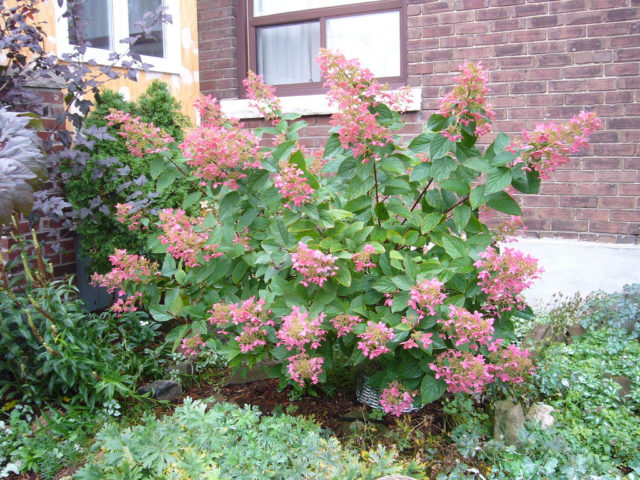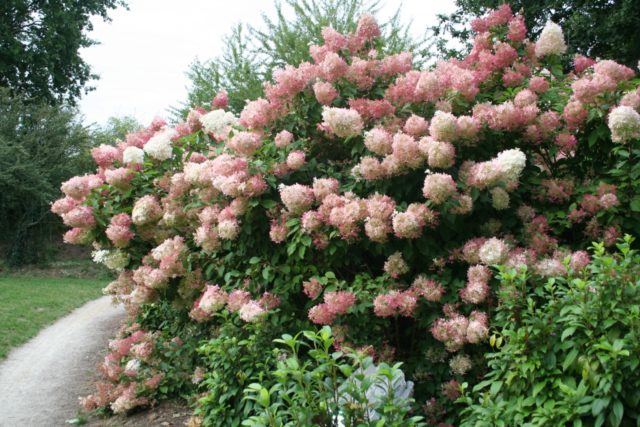Content
One of the more attractive flowering shrubs is the Pink Diamond hydrangea. It produces large inflorescences with very beautiful flowers of white, light pink and deep pink shades. At the same time, Pink Diamond does not belong to particularly demanding crops. Due to its high winter hardiness, it can be bred in almost any region of Russia. Basic maintenance requirements include regular feeding, watering and adequate lighting.
Description of Pink Diamond hydrangea
Hydrangea paniculate Pink Diamond (literally "pink diamond)" is a rather large, spreading shrub that grows up to 1.5-2 m in height. It is one of the most decorative hydrangea varieties, blooming throughout the summer from July to the end of September. Flowers are collected in very large panicle inflorescences (length up to 35 cm).
Initially, the petals are painted in white and cream tones, and towards the end of summer they turn bright pink. The decorative value of hydrangea is associated not only with lush inflorescences, but also with a rather dense crown. Against its rich green background, light petals contrast well, thanks to which the tree takes on a very attractive appearance.

Pinky Diamond hydrangea flowers become especially beautiful in August and September.
Hydrangea Pink Diamond in landscape design
A distinctive feature of the Pink Diamond variety is its lush panicles with numerous bright pink flowers. The ornamental value of the shrub is also associated with its beautiful, large leaves with a matte green surface. Thanks to this combination, this tree can be used to decorate the garden in a variety of ways:
- Single landings.
- Landings near the house, along fences and other structures.
- Several hydrangea bushes, planted in a certain order - for example, in a triangle, also look beautiful.
- A lush, tall bush of Pink Diamond hydrangea can be planted along the path - then it will always be a pleasure to walk along it.
- Pink Diamond is in good harmony with other plants, hedges.
Winter hardiness of Pink Diamond hydrangea
This is one of the most winter-hardy varieties of hydrangeas, which are successfully grown not only in the Middle Lane, but also in other regions of Russia:
- North and Northwest;
- Ural;
- Siberia;
- Far East.
There is evidence that the Pink Diamond hydrangea can withstand even extreme frosts down to -35 degrees. Therefore, adult bushes do not need to be covered - it is enough just to mulch the roots with needles, sawdust and other natural materials.
Planting and caring for Pink Diamond panicle hydrangea
For planting in open ground, seedlings at least 3 years old are used. The optimal planting time is spring (April, after the snow melts). At the same time, planting of Pink Diamond panicle hydrangea is allowed in the fall, but only in the southern regions (Stavropol, Kuban, North Caucasus).
Selection and preparation of the landing site
When choosing a landing site, you should pay attention to several practical recommendations:
- Hydrangea Pink Diamond, like representatives of other varieties, is very fond of illuminated places, but too abundant light will also be harmful. Therefore, it is better to choose a place with a little shade from buildings, trees or shrubs.
- In the south, the shade can be slightly stronger - for example, you can simply plant a hydrangea next to a high fence or house. In the north, you can choose an open or slightly shaded area.
- At the same time, Pink Diamond does not like strong winds, therefore it needs a natural barrier in the form of shrubs or buildings.
- Any varieties of hydrangeas, including Pink Diamond, prefer fertile, moderately acidified soil. At the same time, they grow poorly in neutral soil and do not tolerate earth with an alkaline reaction at all.
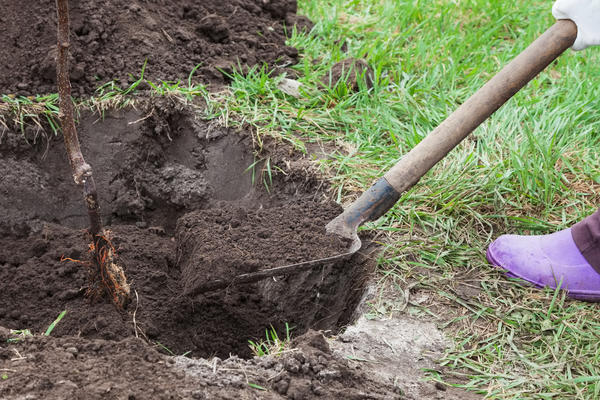
The garden plot does not require special preparation - it is enough to clean, dig up the ground and form a small planting hole
Landing rules
Hydrangea Pink Diamond grows well on black soil and light loam. But even if the soil is not too fertile, it will be possible to breed this plant provided that fertilizers are applied on time. Prepare a soil mixture before planting. It is believed that the following composition is optimal for hydrangeas:
- sheet land (2 parts);
- humus (2 parts);
- peat (1 part);
- sand (1 part).
Another option:
- sheet land (4 parts);
- sod land (2 parts);
- sand (1 part).
Landing is carried out according to the standard technique:
- Dig a small hole with the same diameter and depth (30 cm).
- Sprinkle with 2-3 buckets of water.
- Fall asleep with soil.
- Set the seedling in the center so that the root collar remains on the ground.
- Water again.
- Mulch with needles, sawdust foliage (layer 6-7 cm).
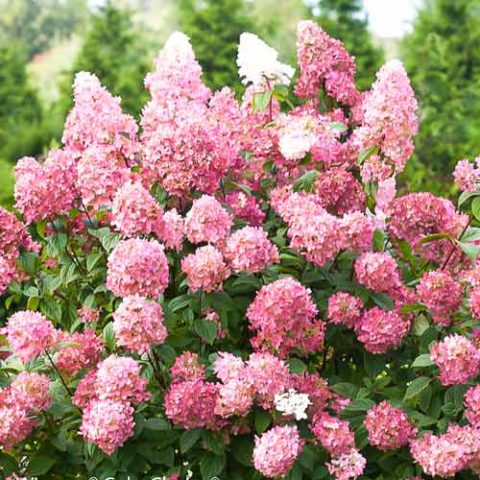
The Pink Diamond bush grows quite widely, therefore, when planting several hydrangeas, an interval of at least 1 m must be observed
Watering and feeding
Any varieties of hydrangeas, including Pink Diamond, love abundant (but moderate) watering. Therefore, it is necessary to observe a certain regime:
- If the rainfall is heavy, you do not need to water the plant - you can pour out 1-2 buckets only once a month, as needed.
- If there is little rain, it is necessary to water it weekly with 2-3 buckets so that the soil remains slightly moistened all days.
- In case of drought, watering is increased up to 2 times a week. But as soon as it rains, it must be stopped - excess moisture harms the hydrangea.
Also, this variety is quite picky about dressing, which is applied several times per season (about 1 time per month) according to the following scheme:
- In the spring, nitrogen fertilizers are applied - it can be saltpeter or organic fertilizing (infusion of mullein or bird droppings).
- In the summer, potash and phosphorus fertilizers are added 2-3 times (monthly). They begin to be introduced from the budding stage.
- At the end of August, fertilizing should be stopped so that the bush can calmly prepare for winter.
Pruning Pink Diamond hydrangea
Pruning Pink Diamond, like most other varieties, is mandatory. Thanks to this, the crown retains an attractive appearance. In addition, removing old branches promotes more lush flowering, since the bulk of the nutrients goes to young, healthy branches.
The bush is trimmed regularly. The main pruning is spring (it is carried out in March, even before the start of sap flow). Using a pruner or garden shears, remove:
- dead, old shoots;
- damaged branches;
- branches protruding strongly beyond the crown.
It is also worthwhile to periodically thin out the crown, cutting off all branches growing inward, and not on the sides. Pruning young shoots is carried out so that 2-3 buds remain as a result. You can repeat the haircut in the fall, shortly before the onset of the first frost.
Preparing for winter
Since the Pink Diamond hydrangea belongs to the winter-hardy varieties, it does not need a special shelter for the winter. However, it is better to cover young seedlings with earth, as well as mulch the roots. To do this, create a layer of needles, sawdust, fallen leaves to a height of no more than 6-7 cm.In the future, this procedure is optional
However, mulching is best done at the beginning of each season. This is especially important in arid regions, as the mulch layer prevents the soil from drying out quickly.
Reproduction of Pink Diamond hydrangea
Hydrangea is bred in different ways:
- cuttings;
- layering;
- seeds.
The easiest way is to obtain layering. The algorithm of actions is as follows:
- In mid-spring, the lower shoot is fixed on a slightly loosened soil and sprinkled so that only the top remains on the surface.
- Water regularly, make sure that the green part grows quickly.
- In September, the roots of the layer are already fully formed - it can be separated from the mother bush.
- Then the layers are seated separately and prepared for wintering (mulching, shelter).
- They need to be planted in their permanent places next spring.
Propagation of hydrangea by cuttings is also quite simple - green cuttings are obtained from the apical shoots in early summer. First, they are rooted in the sand, and after 2-3 months they are transplanted into containers with ordinary fertile soil. Cuttings overwinter indoors, and in spring they are transferred to open ground.
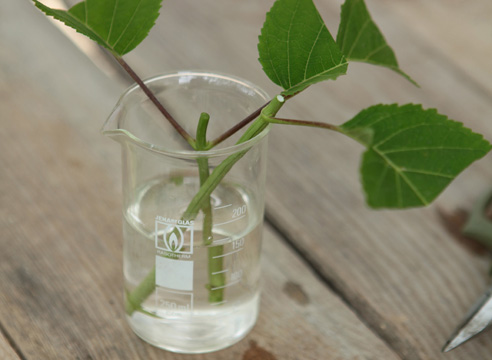
To obtain a cutting of a hydrangea, it is enough to cut off the apical shoot with 2-3 pairs of leaves: the lower pair is removed, and the rest are cut in half.
Diseases and pests
In general, the Pink Diamond variety is resistant to adverse climatic conditions and diseases. But from time to time, he can be struck by various pathologies:
- gray rot;
- powdery mildew;
- leaf spot;
- root rot;
- chlorosis.
In the case of fungal diseases, it is necessary to treat with fungicides. If diseases are associated with improper care (yellowing of leaves due to chlorosis), nitrogen fertilization must be applied. A solution of citric acid (5 g) and ferrous sulfate (3 g) per 1 liter of water is suitable.
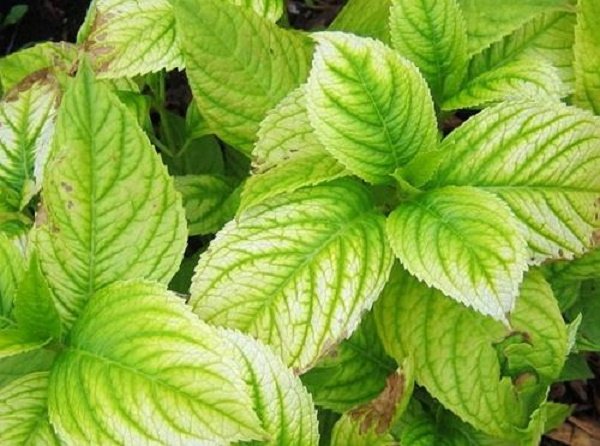
Hydrangea chlorosis can be associated with both insufficient feeding and the spread of infection.
Pink Diamond, like other varieties of hydrangeas, is susceptible to the action of insect pests, for example: aphids, spider mites, leaf rollers. In the fight against them, insecticides and folk remedies are used (infusion of mustard, a decoction of marigold flowers, a solution of soda, laundry soap and others).
Conclusion
Hydrangea Pink Diamond will be a godsend for any garden. It is a complete flowering shrub that looks beautiful even on its own. It is easy to care for, although it requires some attention. Experience shows that hydrangea can be grown even in regions with frosty winters. Moreover, a novice amateur gardener can also cope with this task.

